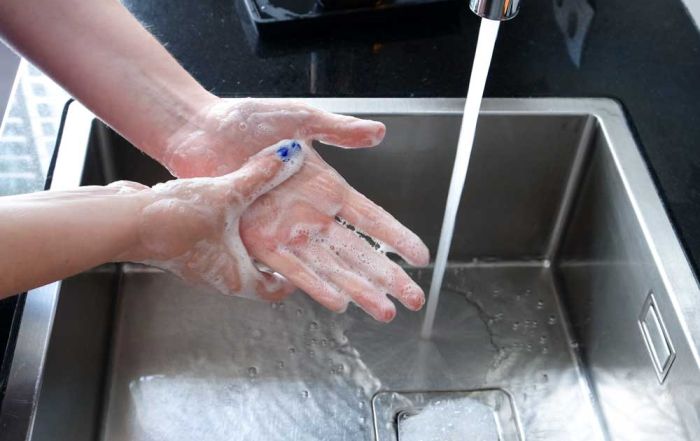Preventing Norovirus in your Foodservice Operation
Norovirus is one of the leading causes of vomiting and diarrhea in the United States, causing between 19 and 21 million illnesses each year. These illnesses result in over 100,000 hospitalizations.
Our foodservice colleagues in certain facets of the industry, such as schools, daycares, healthcare, and cruise ships are particularly susceptible to having to deal with norovirus outbreaks. But norovirus could impact all of us, regardless of how many people we serve or how big our teams are. The good news is that norovirus is highly preventable with proper food safety practices.
First, a bit of background on norovirus and why it is so contagious. As you likely guessed, norovirus is a virus that causes gastrointestinal illness, including vomiting, diarrhea, nausea, and stomach pain. It spreads easily through contaminated food, water, surfaces, and even person-to-person contact. Most cases of norovirus are transmitted through the fecal-oral route. Unlike some bacteria, norovirus can survive on surfaces for days and is resistant to many common disinfectants. Norovirus also spreads easily, with some research noting that from the point of impact of a vomit incident, the virus can spread 25 feet beyond that area. These factors make prevention of norovirus extremely difficult, and thus strict hygiene measures must be implemented to control the spread of the virus.
Handwashing is the single most effective way to prevent norovirus. Remember the basics of proper hand hygiene. Wash hands thoroughly with soap and warm water for at least 20 seconds before preparing or serving food, after using the restroom, and after any activity that could contaminate hands. While alcohol-based sanitizers may be helpful to prevent some viruses, they are ineffective for norovirus.
If you’ve been on a cruise ship recently, you may have noticed all the signs leading to the cafeteria that ask you to wash or sanitize your hands before proceeding through the buffet. Practicing good hand hygiene is one of the best things you can do to keep yourself healthy. If you are in a school, enlist the assistance of teachers and other staff in the front of the cafeteria to encourage students to wash their hands before going through the lunch line.
……[norovirus] spreads easily through contaminated food, water, surfaces, and even person-to-person contact, mostly through the fecal-oral route……
Norovirus spreads rapidly through infected individuals. Any staff showing symptoms of vomiting or diarrhea must stay home for at least 48 hours after symptoms resolve. Schools should also have policies to prevent ill students from handling food or sharing utensils, as even a single infected person can trigger an outbreak.
As previously noted, norovirus can survive on surfaces for days, so regular cleaning and sanitizing are essential. Use approved disinfectants effective against norovirus on food contact surfaces, counters, tables, and cafeteria trays. Clean spills of vomit or diarrhea immediately using gloves, disposable towels, and proper disinfectants. Wash and sanitize dishes, utensils, and cookware thoroughly, preferably in a dishwasher that meets proper temperature requirements.
Since norovirus can be transmitted via contaminated food, strict food handling practices are crucial. Avoid bare-hand contact with ready-to-eat foods; use gloves, utensils, or deli tissue.
Preventing norovirus is only possible if staff understand the risks and protocols. Training should cover proper handwashing and glove use, procedures for cleaning and sanitizing surfaces, policies for reporting illness, and the basics of safe food handling, storage, and preparation practices.
Even with the best prevention measures, outbreaks can still occur. Have a clear response plan if a vomiting or exposed diarrhea incident does occur. This should include isolating the contaminated area and ensuring thorough cleaning and sanitizing before resuming operations.
Norovirus outbreaks can have serious consequences, from widespread illness to disruptions in operations. However, with strict hand hygiene, exclusion policies for sick staff, proper cleaning and sanitizing, safe food handling, and staff training, the risk can be drastically reduced. Risk Nothing.
READ MORE POSTS
30 Years Later: The Foodborne Illness Outbreak that Changed Food Safety
In January, we hit a major anniversary. One I am betting snuck by many of you – including me! January marked 30 years since the deadly 1993 E. coli O157:H7 outbreak at Jack in the Box restaurants on the west coast. The anniversary wasn’t on any of the major news networks that I recall. It did make it into a few newspapers, at least one or two of the newspapers that are left. It wasn’t until late-February that I realized it.
Does Temperature Really Matter when Washing your Hands?
In January, I reviewed the changes to the 2022 Food Code in my blog (check out Part I and Part II), and one change to the food code that I had mentioned, but didn’t discuss in-depth, was the change that lowered the water temperature a hand sink was required to produce to 85°F, as noted in Section 2-202.12 of the code. This requirement has been in place since the publishing of the 2001 Food Code, which required a water temperature of 100°F. Prior to this, 110°F was required (see the 1999 Food Code). So why the change and does water temperature when washing your hands really matter?
Hand sinks: Often Taken for Granted, but an Essential Part to Effective Hand Hygiene
Late in January, I received a question about hand sinks in a foodservice operation. The question pertained to school staff (teachers and aides) who were using a hand washing sink in the school kitchen. The question came as a matter of who was allowed access to the kitchen to use the sink, but the question itself caused me to go down a rabbit hole of requirements for hand washing sinks in foodservice operations.
Hot off the Press: The 2022 Model Food Code has been Released! Part Two.
Earlier in the month, we started a discussion about the changes to the 2022 Food Code. If you missed that post, late in December 2022, the Food and Drug Administration released the 2022 Food Code and I wanted to highlight a few of the changes that have been made to the code.










